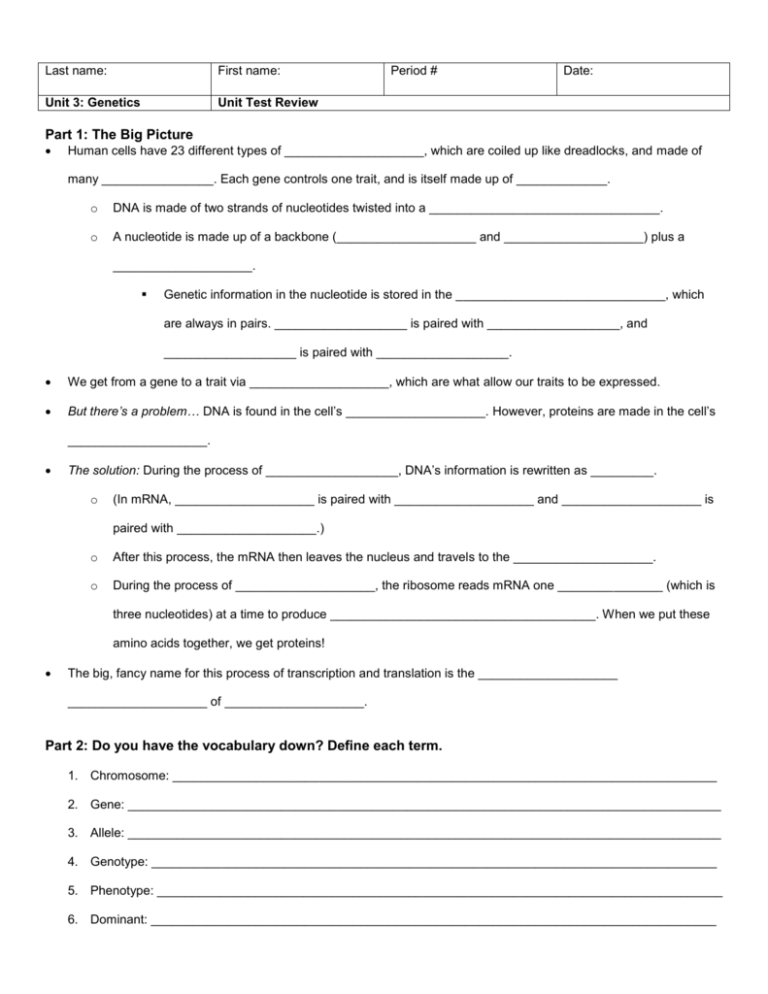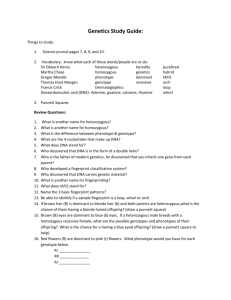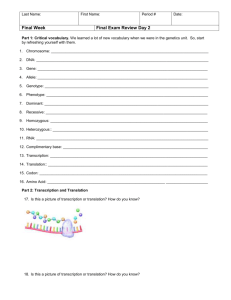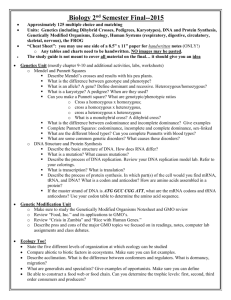GLE- Objective - SanacoreScience
advertisement

Last name: First name: Unit 3: Genetics Unit Test Review Period # Date: Part 1: The Big Picture Human cells have 23 different types of ____________________, which are coiled up like dreadlocks, and made of many ________________. Each gene controls one trait, and is itself made up of _____________. o DNA is made of two strands of nucleotides twisted into a _________________________________. o A nucleotide is made up of a backbone (____________________ and ____________________) plus a ____________________. Genetic information in the nucleotide is stored in the ______________________________, which are always in pairs. ___________________ is paired with ___________________, and ___________________ is paired with ___________________. We get from a gene to a trait via ____________________, which are what allow our traits to be expressed. But there’s a problem… DNA is found in the cell’s ____________________. However, proteins are made in the cell’s ____________________. The solution: During the process of ___________________, DNA’s information is rewritten as _________. o (In mRNA, ____________________ is paired with ____________________ and ____________________ is paired with ____________________.) o After this process, the mRNA then leaves the nucleus and travels to the ____________________. o During the process of ____________________, the ribosome reads mRNA one _______________ (which is three nucleotides) at a time to produce ______________________________________. When we put these amino acids together, we get proteins! The big, fancy name for this process of transcription and translation is the ____________________ ____________________ of ____________________. Part 2: Do you have the vocabulary down? Define each term. 1. Chromosome: ______________________________________________________________________________ 2. Gene: _____________________________________________________________________________________ 3. Allele: _____________________________________________________________________________________ 4. Genotype: _________________________________________________________________________________ 5. Phenotype: _________________________________________________________________________________ 6. Dominant: _________________________________________________________________________________ 7. Recessive: _________________________________________________________________________________ 8. Homozygous: _______________________________________________________________________________ 9. Heterozygous: ______________________________________________________________________________ 10. Co-dominance: _____________________________________________________________________________ 11. Nucleotide: _________________________________________________________________________________ 12. DNA: _____________________________________________________________________________________ 13. RNA: _____________________________________________________________________________________ 14. Backbone: _________________________________________________________________________________ 15. Base: _____________________________________________________________________________________ 16. Transcription: _______________________________________________________________________________ 17. Translation: ________________________________________________________________________________ 18. Codon: ____________________________________________________________________________________ 19. Amino acid: _____________________________________________________________________ ___________ Part 3: Practice Transcription and Translation Knowledge and Skills 20. One strand of DNA reads: TCAGTC. What is the complementary DNA strand? 21. One strand of DNA reads: GGCTAA. What is the complementary RNA strand? 22. Translate the RNA you created in #20 into amino acids using your codon table. 23. Place the following terms in the rings of the target to the right: DNA, chromosome, gene, cell. The smallest term should go in the center of the target, and the largest term should go on its outside. 24. Is this a picture of transcription or translation? How do you know? 25. Is this a picture of transcription or translation? How do you know? Ribosome 26. Fill in the boxes of the flowchart below with the following words: trait, DNA bases, amino acids, proteins. 27. Complete this chart comparing and contrasting DNA and RNA. DNA RNA Shape and number of strands Type of sugar in backbone Type of bases used Is it (the DNA/RNA) made of nucleotides? Where is it found? Part 4: Practice Punnett Square Skills 26. Simba got his beautiful brown eyes from his parents Mufasa and Sarabi. However, both his parents had yellow eyes. Show that this is possible since both his parents are heterozygous. (Brown is dominant over yellow). Percent chance Simba would be homozygous dominant: _________ Percent chance Simba would be heterozygous: _________ Percent chance Simba would be homozygous recessive: _________ Percent chance Simba would have brown eyes: _________ 27. Pouncing is a very important skill for lions to hunt. Poor pouncing is dominant to good pouncing. Both Simba and Nala are good pouncers. Knowing this, can they have any children who are bad pouncers? Can Simba and Nala have a bad pouncer? Explain your answer in complete sentences. How do you know? 28. Let's say that in seals, the gene for stripes is dominant to the gene for solid color. a. What percentage of offspring would be expected to have a solid color from the cross of two striped seals, one which is homozygous dominant and the other who is heterozygous? b. If one parent seal is homozygous recessive and the other is solid, what percent of offspring would be heterozygous? What about having a solid color? c. Draw a Punnett square to show what would happen if two heterozygous seals had children. Then, answer the questions below. Parent genotype = __________ Parent phenotype = _________ Chance of having homozygous dominant offspring = ____% Chance of having heterozygous offspring = ____% Chance of having homozygous recessive offspring = ____% Chance of having offspring with solid color = _____% Chance of having offspring with stripes = _____% Part 5: Blood Typing and Punnett Squares 29. Tanya and Jerome want to have a child. Tanya is heterozygous for type B blood and Jerome is homozygous for type A blood. A. What is Tanya’s phenotype? _____________ Jerome’s phenotype? _____________ B. What is the percent chance their children will have Type A blood? ________ C. What is the percent chance their children will have Type B blood? _________ D. What is the percent chance their children will have Type AB blood? _________ E. What is the percent chance their children will have Type O blood? __________ F. What is the percent chance their children will be ii? ___________ 30. Denice is pregnant and just told her husband John. However, Denice wonders if the mailman might actually be the father of her child. Denice has an IAi genotype, while the mailman has type O blood. The child was tested and has type AB blood. Was the mailman the father of the baby? What would John’s genotype have to be to make the baby his? Part 5: Multiple choice questions. You can do it!!!! 29 In humans, the gene for polydactyl (having extra fingers or toes) is dominant over the gene for the normal number of digits. If parents who are both homozygous dominant for polydactyl have four children, how many of these children would most likely have extra fingers or toes? (1) 0 (3) 3 (2) 2 (4) 4 32 In a portion of a gene, the nitrogenous base sequence is T–C–G–A–A–T. Which nitrogenous base sequence would normally be found on the complimentary strand of DNA to this section of the gene? (1) A–C–G–T–A–A (2) A–C–G–U–U–A (3) A–G–C–T–T–A (4) U–G–C–A–A–U 30 The structure and location of a cellular component is represented in the diagram below. 33 Which processes occur in the nucleus? (1) 1 and 2 (3) 3 and 4 (2) 2 and 3 (4) 4 and 5 The polymer in the diagram most likely contains 1 adenosine triphosphate 2 lipids 3 the bases A, T, G, and C 4 hydrolytic enzymes 34 What is the product of process 3? 1 a strand of DNA 2 two complementary strands of DNA 3 a strand of RNA 4 a chain of amino acids








